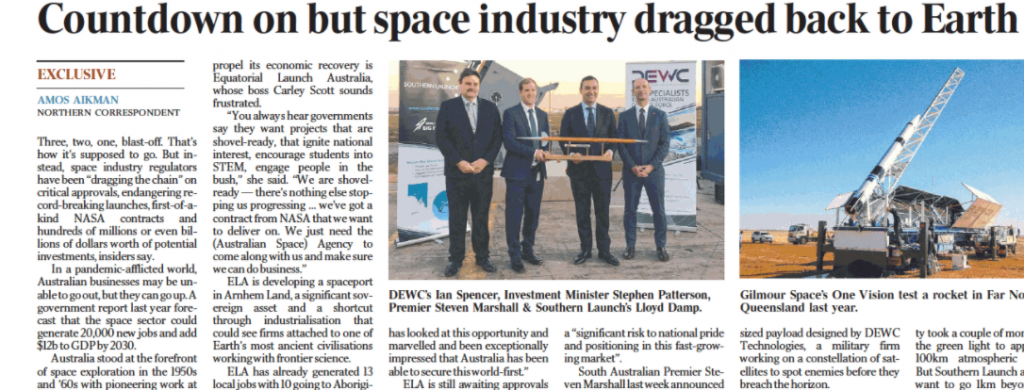
Article by Amos Aikman courtesy of the Australian
Three, two, one, blast-off. That’s how it’s supposed to go. But instead, space industry regulators have been “dragging the chain” on critical approvals, endangering record-breaking launches, first-of-akind NASA contracts and hundreds of millions or even billions of dollars worth of potential investments, insiders say.
In a pandemic-afflicted world, Australian businesses may be unable to go out, but they can go up. A government report last year forecast that the space sector could generate 20,000 new jobs and add $12b to GDP by 2030.
Australia stood at the forefront of space exploration in the 1950s and ’60s with pioneering work at places like Woomera. But after that it began to languish, some say through government inattention to the vital needs of entrepreneurs and researchers.
One firm seeking to help Australia recapture a leading role and propel its economic recovery is Equatorial Launch Australia, whose boss Carley Scott sounds frustrated.
“You always hear governments say they want projects that are shovel-ready, that ignite national interest, encourage students into STEM, engage people in the bush,” she said. “We are shovelready — there’s nothing else stopping us progressing … we’ve got a contract from NASA that we want to deliver on. We just need the (Australian Space) Agency to come along with us and make sure we can do business.”
ELA is developing a spaceport in Arnhem Land, a significant sovereign asset and a shortcut through industrialisation that could see firms attached to one of Earth’s most ancient civilisations working with frontier science.
ELA has already generated 13 local jobs with 10 going to Aboriginal people. The company was meant to send its first NASA rocket skywards this dry season, which would have been the agency’s first commercial spaceport launch.
“This is a really big deal,” Ms Scott said. “The rest of the world has looked at this opportunity and marvelled and been exceptionally impressed that Australia has been able to secure this world-first.”
ELA is still awaiting approvals to operate its facility and for longplanned takeoffs. Had the coronavirus pandemic not intervened, delaying NASA, the regulatory hold-ups would have precluded ELA meeting contractual obligations, something Scott describes as a “significant risk to national pride and positioning in this fast-growing market”.
South Australian Premier Steven Marshall last week announced that Southern Launch would send Australia’s first commercial spacecapable rocket to the edge of the atmosphere on 15 September. The craft, which resembles a hyperdrive-equipped Hills Hoist pole, will carry a whiteboard markersized payload designed by DEWC Technologies, a military firm working on a constellation of satellites to spot enemies before they breach the horizon.
Southern Launch boss Lloyd Damp says his firm began the approvals process for its “very small and low-risk operation” — approvals he thinks might take a fortnight in the US — last September. The Civil Aviation Safety Authority took a couple of months to give the green light to approach the 100km atmospheric boundary. But Southern Launch and DEWC want to go 1km beyond that to make the flight historic and test the DEWC payload’s electronicwarfare capabilities.
The difference between the two flight paths equates to a change in the nose-angle at launch. It’s the same rocket. Same fuel. Same payload. But Southern Launch and DEWC have no idea when the ASA may let them blast that extra kilometre.
DEWC’s Ian Spencer sees New Zealand pulling ahead with its successful firm Rocket Lab. He believes reaching space commercially from Australia is a crucial step towards building confidence in the industry Down Under.
“Everyone is excited about it, everyone wants to be part of this, and it’s the right time in history to be doing it,” he said.
“But just to get to this last hurdle and the regulator’s sort of dragging the chain a little bit — I don’t want to bag them and put them off-side, and we’ll never get the thing launched, but it certainly is a frustration.”
Space Industry Association deputy chair Melissa de Zwart says the launch approval delays are “fairly serious”, adding that regulatory environment is the “key determinant” of investment flows in a globally competitive market. She also says Australians take for granted many everyday gadgets and services that secretly rely on space to operate.
“People in lockdown have been watching Netflix, internet shopping homeschooling, using Zoom
— what would we do without all of those things?” she asks.
Professor de Zwart sees Australia as poised as in the ‘50s and ‘60s, reliant on government enthusiasm to decide if its industry can grow into a leading role or will be confined to a bit part.
An ASA spokeswoman says the Agency will “continue to work closely with companies such as Southern Launch and Equatorial Launch Australia regarding their obligations … (and) with the industry on providing a regulatory environment that ensures safe and responsible space activities, as well as encouraging innovation and entrepreneurship.”
Adam Gilmour is a former banker who now runs Gilmour Space Technologies, a Queensland-based rocketry firm with ambitions to triple its 55 employees and reap revenues “north of $100m” in a few years.
“When Australia starts launching stuff into space, that will inspire the country to think a bit bigger,” he said.
